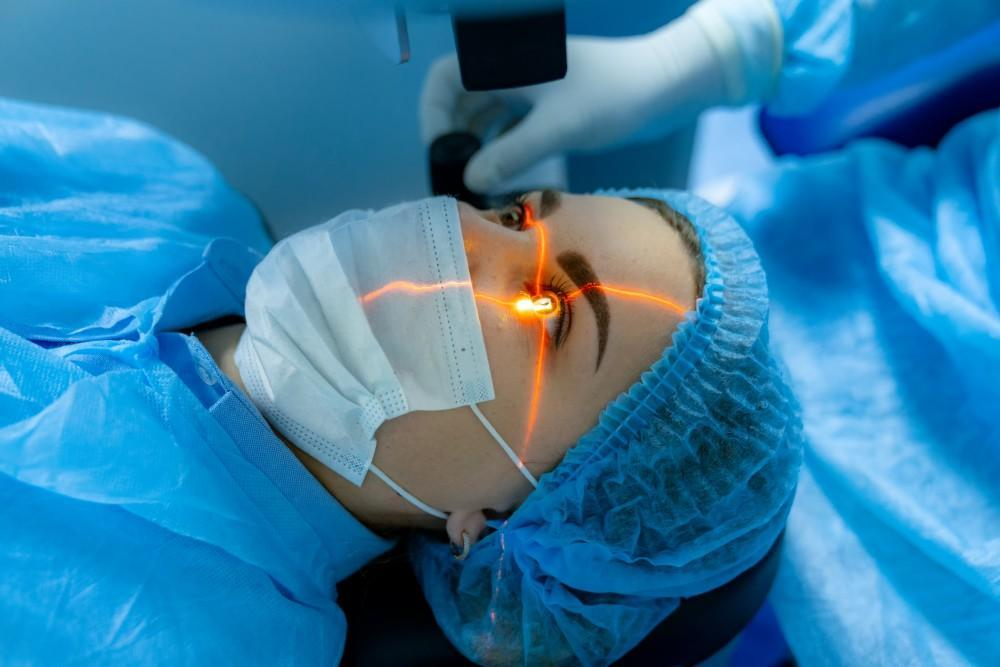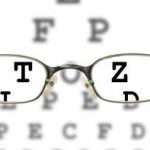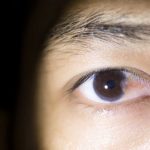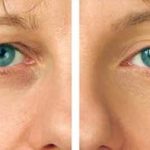What is LASIK eye surgery?
LASIK eye surgery is the best known and most commonly performed laser refractive surgery to correct vision problems. Laser-assisted in situ keratomileusis (LASIK) can be an alternative to glasses or contact lenses. During LASIK surgery, a special type of cutting laser is used to change the shape of the cornea. The cornea is the dome-shaped clear tissue at the front of the eye. In eyes with typical vision, the cornea bends — or refracts — light precisely onto the retina at the back of the eye. But with nearsightedness, farsightedness or astigmatism, the light is bent incorrectly. This incorrect refraction causes blurred vision. Glasses or contact lenses can correct vision, but reshaping the cornea also provides the refraction needed to correct vision.

Why it’s done
LASIK surgery may be an option for the correction of these vision problems:
- Nearsightedness, also called myopia. In nearsightedness, your eyeball is slightly longer than typical or the cornea curves too sharply. This causes light rays to focus in front of the retina, which makes distant vision blurry. Objects that are close can be seen fairly clearly. But objects in the distance will be blurry.
- Farsightedness, also called hyperopia. In farsightedness, you have a shorter than average eyeball or a cornea that is too flat. This causes light to focus behind the retina instead of on it. This makes near vision, and sometimes distant vision, blurry.
- Astigmatism. In astigmatism, the cornea curves or flattens unevenly. This affects focus of near and distant vision.
If you’re considering LASIK surgery, you probably already wear glasses or contact lenses. Your eye doctor will talk with you about whether LASIK surgery or another similar refractive procedure is an option that will work for you.

How Much Is Lasik Surgery In Iran?
Depending on where and in which country the surgery is performed, LASIK costs vary significantly. Fortunately, the price of LASIK eye surgery in Iran is a low fraction of its prices in other countries. LASIK surgery is an outpatient procedure in Iran and costs from $700 to $1,400 per eye (including all the related medical fees). Costs of laser eye surgery in other countries are higher. For example, the average cost of this procedure in the United States is approximately $2,100 per eye. In the UK, the LASIK costs around £3,000 per eye.

How Is Lasik Surgery Performed?
First, the patient is asked to lie on the back and remain still. Topical eye drops are used to numb the eye, so the patient does not feel pain. Also, the area around the eye is washed and cleansed. He or she may also be given a sedative to help relaxation.
After preparation, the surgeon uses an instrument called lid speculum to hold the eyelids open. Then a ring is placed on the eye that creates suction on the cornea. The patient may feel pressure and experience dimming of the vision at this point in the surgery.
Once the ring is firmly in place the surgeon attaches a special device called a microkeratome to the suction ring. Using the blade on the microkeratome, the surgeon creates a corneal flap by cutting approximately the outermost of the cornea and lifts it carefully to one side.
When the suction ring in microkeratome is removed, the surgeon uses pulses from a computer-controlled exciplex laser to reshape the cornea by vaporizing tiny portions of its interior. This part of the procedure usually takes less than one minute. The surgeon then places the corneal flap into its original position and observes the eye for several minutes to ensure bonding. Stitches are not used in this type of surgery, because the cornea bonds and heals on its own.
Finishing the procedure, the surgeon administers antibiotic drops and places a shield over the eye to prevent the patient from rubbing it or from putting pressure on it while the patient is asleep.
Before Lasik Surgery
The doctor will inform the patient about the risks and benefits of a LASIK surgery, and other possible alternatives to the surgery. The surgeon also will provide information to the patient about what to expect before, during, and after the procedure. It is important for the patient to learn the facts about the outcomes before undergoing the surgery. For a safe and effective outcome, the surgeon carefully evaluates the patient to determine if he or she, is the right candidate for a LASIK. Next, eye measurements and check-ups are performed on the patient for dry eyes, large pupils and thin corneas, since these conditions may lead to serious complications. It is also important that the patient informs the surgeon or the doctor about any eye or other medical conditions, because it may result in unsatisfying results.
Recovery After Lasik Eye Surgery
Recovery from laser eye surgery is an gradual process. It will take around 7 days for you to be able to go back to your normal life. However, during these 7 days, you won’t be much restricted in activities. You should expect to feel itching and burning in the treated eye.
Since the patient cannot drive immediately following the procedure, he or she needs to make arrangements for a ride home. The patient should also keep his/her eyes clean and avoid rubbing them for at least 1 week.
Vision improvement will happen gradually since the first day after the procedure. Generally, it takes around 2 weeks to 2 months and more to fully recover. If you have a higher prescription number, you will experience it a lot faster.

Is Lasik Eye Surgery Safe?
LASIK is a safe procedure as it brings minimum side effects. However, as with any surgery, it is important that before having the procedure, the person be fully informed about the risks and outcomes of the surgery. Though very rare, these complications include dry eyes, sensitivity to light, blurred vision, and other visual symptoms, such as double vision.
Such symptoms are commonly mild and temporary. In addition to that, the patient’s vision may not be fully corrected after the surgery and may not last. It may require vision correction and further treatment to get the desired outcome.
Risks
Complications that result in a loss of vision are very rare. But certain side effects of LASIK eye surgery are common. These include dry eyes and temporary visual problems such as glare. These symptoms usually clear up after a few weeks or months. Few people consider them to be a long-term problem.
Risks of LASIK surgery include:
- Dry eyes. LASIK surgery causes a temporary decrease in tear production. For the first six months or so after your surgery, your eyes may feel unusually dry as they heal. Dry eyes can reduce the quality of your vision.
Your eye doctor might recommend eye drops for dry eyes. If you experience severe dry eyes, your eye doctor may recommend additional management, including tear drain plugs or medicated eye drops.
- Glare, halos and double vision. You may have a hard time seeing at night after surgery. This usually lasts a few days to a few weeks. You might notice increased light sensitivity, glare, halos around bright lights or double vision.
Even when a good visual result is measured under standard testing conditions, your vision in dim light (such as at dusk or in fog) may be reduced to a greater degree after the surgery than before the surgery.
- Undercorrections. If the laser removes too little tissue from your eye, you won’t get the clearer vision results you were hoping for. Undercorrections are more common for people who are nearsighted. You may need another LASIK procedure within a year to remove more tissue.
- Overcorrections. It’s also possible that the laser will remove too much tissue from your eye. Overcorrections may be more difficult to fix than undercorrections.
- Astigmatism. Astigmatism can be caused by uneven tissue removal. It may require another surgery, glasses or contact lenses.
- Flap problems. Folding back or removing the flap from the front of your eye during surgery can cause complications, including infection and excess tears. The outermost corneal tissue layer may grow abnormally underneath the flap during the healing process.
- Corneal ectasia. Corneal ectasia, a condition in which the cornea is too thin and weak, is one of the more-serious complications. The abnormal cornea tissue is unable to maintain its shape, which can lead to cornea bulging and worsening vision.
- Regression. Regression is when your vision slowly changes back toward your original prescription. This is a less common complication.
- Vision loss or changes. Rarely, surgical complications can result in loss of vision. Some people also may not see as sharply or clearly as previously.
What you can expect
Before the procedure
Long-term results from LASIK tend to be best in people who are carefully checked before surgery to see if they are good candidates for the procedure.
If you wear contact lenses, you’ll need to stop wearing them and wear only your glasses for at least a few weeks before your evaluation and surgery. This is because contact lenses can change the shape of your cornea. Your eye doctor will provide specific guidelines depending on the type of contacts you wear and how long you’ve been a contact lens wearer.
During the evaluation, your eye doctor will ask about your medical and surgical history and give you a complete eye examination to check your vision and decide whether you can undergo the procedure safely.
Your eye doctor will look for signs of:
- Eye infection.
- Inflammation.
- Dry eyes.
- Large pupils.
- High eye pressure.
Your eye doctor will also measure your cornea, noting the shape, contour, thickness and any irregularities. Your eye doctor will check which areas of your cornea need reshaping and determine the exact amount of tissue to remove from your cornea.
Doctors generally use wavefront-guided technology to check your eye in detail before LASIK surgery. In this test, a scanner creates a highly detailed chart, similar to a topographic map, of your eye. The more detailed the measurements, the more accurate your eye doctor can be in removing corneal tissue.
Before surgery, your doctor will discuss the risks and benefits of LASIK surgery, what to expect before and after surgery, and any questions you may have.

During the procedure
LASIK surgery is usually completed in 30 minutes or less. During the procedure, you lie on your back in a reclining chair. You may be given medicine to help you relax. After numbing drops are placed in your eye, your doctor uses an instrument to hold your eyelids open.
A suction ring is placed on your eye just before cutting the corneal flap. This may cause a feeling of pressure, and your vision may dim a little.
Your eye surgeon uses a small blade or cutting laser to cut a small hinged flap away from the front of your eye. Folding back the flap allows your doctor to reach the part of your cornea to be reshaped.
Using a programmed laser, your eye surgeon reshapes parts of your cornea. With each pulse of the laser beam, a tiny amount of corneal tissue is removed. After reshaping the cornea, the surgeon lays the flap back into place. The flap usually heals without stitches.
During the surgery, you’ll be asked to focus on a point of light. Staring at this light helps you keep your eye fixed while the laser reshapes your cornea. You may notice a distinct odor as the laser removes your corneal tissue. Some people describe smelling an odor similar to that of burning hair.
If you need LASIK surgery in both eyes, doctors will generally do the procedure on the same day.
After the procedure
Immediately after surgery, your eye might itch, feel gritty, burn and be watery. You’ll probably have blurred vision. You generally will experience little pain, and you’ll usually recover your vision quickly.
You might be given pain medicine or eye drops to keep you comfortable for several hours after the procedure. Your eye doctor might also ask you to wear a shield over your eye at night until your eye heals.
You’ll be able to see after surgery, but your vision won’t be clear right away. While vision after LASIK is generally good within a few days, it can be up to 2 to 3 months after your surgery before your eye heals completely and your vision stabilizes. Your chances for improved vision are based, in part, on how good your vision was before surgery. You’ll have a follow-up appointment with your eye doctor 1 to 2 days after surgery. This is to see how your eye is healing and check for any complications. Plan for other follow-up appointments during the first six months after surgery as your doctor recommends. It might be a few weeks before you can start to use cosmetics around your eyes again. You also might have to wait several weeks before resuming strenuous contact sports, swimming or using hot tubs.Follow your doctor’s recommendations about how soon you can resume your usual activities.




















